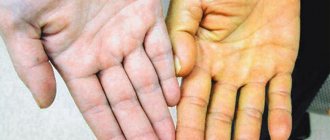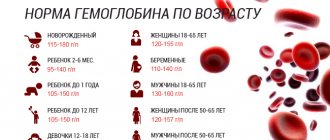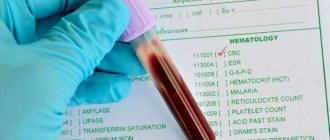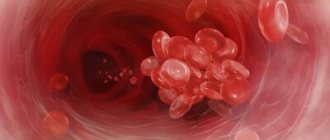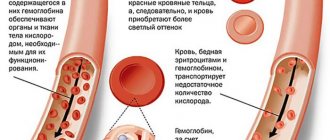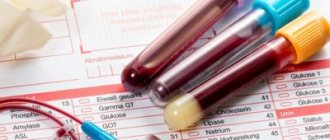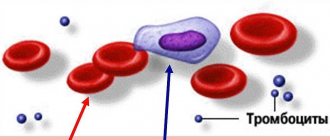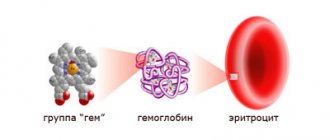Increased hemoglobin, red blood cells and hematocrit: causes, treatment
The results of an extensive blood test allow the doctor to understand why the patient has high hemoglobin, what is the ratio of red blood cells, platelets and hematocrit. The concept of “norm” is not universal. We can talk about an increased or decreased level only taking into account the age, presence of unfavorable working or living conditions, gender and health status of the patient. An increased hematocrit is the result of an increase in the ratio of basic formed elements. This happens against the background of chronic diseases and pathological conditions.
Restoring standard value
A decrease in hematocrit value is one of the symptoms of a chronic disease, an inflammatory process, or fatigue. If the doctor has ruled out factors that provoke a decrease in the indicator in the short term, it is necessary to find the true cause. The patient is referred to specialized medical specialists for additional examination. The collected information will allow us to conclude why the patient has a low level of red blood cells and a hematocrit below normal.
The initial form of iron deficiency in the body is eliminated by taking dietary supplements. The doctor has the final say. The drug is selected taking into account the patient’s health condition. The second element of the treatment course is a balanced diet:
- seafood;
- chicken eggs;
- legumes;
- liver;
- red grapes;
- pomegranate;
- dried fruits;
- chicken.
The third element of the therapeutic course is vitamin C, which accelerates the processing of iron in the body. The choice is made in favor of natural fruits or nutritional supplements.
On a note! The last option is appropriate in the off-season, when it is difficult to find fresh citrus fruits.
When you can't do without hospitalization
Shortness of breath, hair loss, pale skin, heart rhythm disturbances are symptoms of acute lack of Fe in the body. The patient requires immediate hospitalization to stabilize his condition. The patient is prescribed a drip to restore the natural value of red blood cells and hematocrit. Untimely contacting a doctor with a reduced concentration of blood cells provokes irreversible changes in the body:
- kidney dysfunction;
- blood vessels lose elasticity, which reduces the volume of blood passed through;
- liver dysfunction;
- activation of inflammatory processes;
- development of malignant neoplasms.
The patient is prescribed medications that will return iron to its previous level. The underlying disease requires treatment. In more serious cases, blood transfusions are performed.
Traditional medicine tips
The initial stage of iron deficiency in the body can be eliminated using rosehip tincture. Ready-made tea bags are sold in pharmacies. Brew a healthy drink every morning and evening. It would be a mistake to increase the amount of juice consumed. On the one hand, apples, grapes, lemons and other citrus fruits are rich in vitamin C and Fe. On the other hand, their concentration is maintained only when the product is eaten in its pure form.
A person should not use exclusively traditional methods for prevention and treatment. In a situation where hemoglobin, red blood cells and hematocrit are low, the use of medications is required.
External and internal risk factors
The doctor, having recorded a deviation from the norm, deals with the reasons for what happened. There are two of them – external and internal. If the problem is short-term and the patient has no other symptoms, then dehydration is to blame. The lower the level of fluid concentration in the blood, the correspondingly less formed elements in the bloodstream. The hematocrit will return to normal as the drinking regime normalizes. No treatment required. Other possible reasons:
- Diseases of the respiratory system - the less oxygen supplied with each breath, the lower the level of concentration of formed elements. The body, trying to stabilize a person’s condition, increases the generation of red cells.
- Congenital pathologies of the cardiovascular system - indicators are increased due to a violation of the integrity of the septum located between the two halves of the heart. The organ stops pumping the required volume of blood, which provokes oxygen starvation.
- Oncological pathologies of the kidneys - malignant and benign neoplasms lead to a sharp increase in the level of erythropoietin concentration. A chain reaction is started, which leads to an increase in hematocrit.
Bad habits should not be written off. Addiction to tobacco products provokes a sharp decrease in oxygen in the blood in children and adults during active and passive smoking. Living in high mountains and genetic predisposition are two reasons that manifest themselves over time. It is difficult to trace their influence.
Causes of high hemoglobin levels
If red blood cells are elevated, this also means a high concentration of iron-containing protein. Deviation from the norm of these indicators occurs when the body does not have enough fluid in hot weather or during intense physical activity. An increased risk of blood clots, strokes, and heart attacks due to higher blood viscosity is what is dangerous about a high level of hemoglobin caused by external factors. Increased water consumption will restore normal functioning of the body in a few days.
A higher than normal level of red blood cells may indicate a lack of oxygen in the body as a result of being at altitude or smoking. But often such a high indicator is a symptom of dangerous diseases in the body:
- increased production of red blood cells by the bone marrow as a result of pathologies;
- impaired renal function with the release of the hormone erythropoietin;
- heart and lung diseases;
- intestinal obstruction;
- diabetes mellitus;
- oncology.
In men
An increase in red blood cells in men is observed not only as a symptom of the disease. Such a malfunction in the body occurs due to hard physical work, grueling training without proper drinking regimen, frequent stay at altitude (pilots, climbers) or smoking. What is the danger of high hemoglobin? In the future, an indicator above the norm, caused by lifestyle, threatens to disrupt normal blood circulation and becomes the main cause of serious life-threatening diseases - vein thrombosis, strokes, and heart attacks.
Among women
High levels of iron-containing protein are not typical for women, but are often found in those living in mountainous areas, with regular intense physical activity or with pathologies of the heart and lungs. During pregnancy, the female body is purposefully saturated with iron to a greater extent for the normal development of the fetus through a special diet and taking multivitamin complexes, which explains high hemoglobin during pregnancy. But over the course of this period, the indicator decreases, the body redistributes the required level to the child. Find out which foods that increase hemoglobin during pregnancy should be added to your diet.
In children and adolescents
If living in a mountainous area and intense physical activity are excluded as possible factors for an increase in iron-containing protein in a child, an examination should be carried out to identify the disease. The main reasons for elevated levels of this protein in children are blood diseases, congenital pathologies of the lungs and heart, intestinal obstruction, and severe dehydration. The level of red cells rises sharply temporarily if the child has received a severe burn; this is necessary to saturate damaged tissues with oxygen and speed up their regeneration.
Development of chronic diseases
The second category of reasons is internal.
They are caused by the presence of a chronic disease, polycythemia, which can be primary or secondary. The patient is diagnosed with elevated hemoglobin, platelets and red blood cells. Malignant neoplasm, chronic form of oxygen starvation, excessive level of red blood cell generation in the spinal cord are some of the possible causes. The patient undergoes an extensive blood test and is examined by other doctors. The task of doctors is to exclude diagnoses with a similar clinical picture. The diagnosis of polycythemia is made if the hematocrit level is exceeded by more than 52% in men and more than 48% in women.
After processing the results of the examination, the doctor will determine the form of the disease. Primary polycythemia is caused by a hereditary predisposition. The body cannot cope with the production of the required volume of red blood cells. The secondary type of disease is the result of exposure to external negative factors. The body sharply increases the production of red cells against the background of hormonal imbalance, which in turn prevents the bone marrow from regulating the balance of formed elements.
Causes of low hematocrit
Anemia can develop as a result of a lack of blood cells according to the ml/liter scheme in the following cases:
- During pregnancy (especially in the second half of the term),
- During blood loss, including during menstruation, after injuries, gynecological diseases, fractures and internal bleeding,
- If, on the contrary, the blood volume is increased relative to the number of red blood cells (fluid accumulation or overhydration may be associated with intravenous infusions or infectious infections),
- If the blood is very thin,
- For those who are fasting, on a strict, exhausting diet, or eating poorly,
- As a result of the slow formation of red blood cells and low levels of hemoglobin in the blood,
- With hyperproteinemia (with multiple myeloma),
- With liver dysfunction,
- If you take biological material for analysis from a person who is in a horizontal position, or if a person is seriously ill and is forced to lie down for a long time.
There are a huge number of factors that influence hematocrit levels - even people living at different altitudes relative to sea level will have different HCT values. A large percentage of red blood cells means a person has polycythemia (increased Hst), and if it is very low, then anemia.
What disease can develop with a decrease in indicators:
- Vascular and hepatic pathologies,
- Nephropathy (with polycystic kidney disease, renal artery stenosis, renal failure),
- Anemia (low blood cell levels),
- Chronic inflammatory pathological processes,
- Oncological diseases in the bone marrow area, dangerous tumors (cancer).
All these ailments are very dangerous to human life and health, but they can be avoided if you conduct a timely examination: take a test and determine what exactly affected your body and lowered the level of blood cells.
High hematocrit levels in children
If red blood cells are elevated in the blood of a minor, a visit to the pediatrician is required. Unlike an adult, the level of deviation from the norm does not matter. The indicator may be 1% or 10% higher or lower. Possible reasons include:
- placental insufficiency;
- disruption of oxygen supply to the fetus during childbirth;
- blood transfusion.
Deviation from the norm should not always be interpreted as pathology. In newborns, the rate may be 1-2% higher than the threshold value. By 12 months, the indicator varies by 10-11%. If the blood test does not show any other abnormalities, then the child does not require treatment. Every year the minor undergoes an examination to monitor his health.
Drug and alternative treatment
Do not neglect taking specialized medications. For anemia, erythropoiesis-stimulating drugs are usually prescribed, which make the process of red blood cell production more active.
If the hematocrit has dropped due to heavy bleeding, then the following measures are taken:
- It is necessary to immediately stop any bleeding (internal or external), eliminating its cause, in order to avoid a further drop in the number of red blood cells in the blood.
- One of the options for restoring normal hematocrit levels is intravenous infusion with the addition of drugs containing iron. This therapy will help replenish the volume of lost biological fluid.
- In case of particularly severe blood loss, the patient is given a blood transfusion. However, this is very risky, as there is a risk of contracting other diseases during the transfusion procedure. Therefore, this measure is applied only in exceptional cases.
Traditional medicine will also help raise the hematocrit level. At the initial stage of iron deficiency, treatment with rosehip tincture is effective. Ready-made tea bags can be purchased at pharmacies. The drink is prepared and drunk twice a day: in the morning and in the evening. However, when treating, you should not limit yourself to traditional methods; they only serve as a complement to drug therapy. With proper treatment, an increase in hemoglobin levels by an average of 1-2 units is observed every week.
Patients whose hematocrit is below 13% require urgent hospitalization. To bring the number of red blood cells back to normal and stabilize the general condition of patients, they are given IVs.
Therapeutic course
Treatment of high level of concentration of formed elements begins with diagnosis. The situation can only be stabilized by eliminating the underlying disease. You can't hesitate. The greater the deviation from the norm, the more viscous the blood becomes. It is unable to deliver oxygen to organs and tissues. The doctor will need less time if the problem is caused by the following factors:
- long-term use of certain medications;
- acute blood loss;
- acute intoxication;
- excess body weight;
- constant nervous tension;
- addiction to alcohol;
- lack of physical activity.
Having eliminated the negative factor, the doctor achieves positive changes within 2-3 weeks.
If, after repeated analysis, it is clear that the patient’s hematocrit is increased, the doctor selects a different course of treatment.
Therapy is symptomatic. Short-term loss of sensitivity in the limbs, changes in skin color, “spots” before the eyes are the result of insufficient oxygen supply to tissues and organs. The doctor recommends giving up bad habits and reviewing your diet. Increase your intake of blood thinning products:
Children's tests - what to prepare for
Newborns often exhibit hyperprolactinemia, indicating an increase in protein in the blood plasma. It is caused by feeding the child milk from a goat or cow (situation: the mother is not able to breastfeed) with a high protein content. To increase the tendency for blood to thicken, you should buy milk with less protein.
Danger - a child with a lower number of red blood cells than normal experiences oxygen starvation.
Over the age of 3 years, there is a decrease in mental abilities, fatigue, shortness of breath, pale skin color and rapid heartbeat. Among the diseases in children, there are all the diseases characteristic of this group, however, unpleasant conditions are also caused by trivial vitamin deficiency.
Helminthic infection, which is more typical for children and adolescents than for adults, can be eliminated by taking anthelmintic drugs, after a course of which the tests return to normal.
What causes increased red blood cells and hemoglobin in the blood?
Hemoglobin is an element that is found inside the red blood cell. In its structure, it consists of an iron ion and a protein part. Due to various circumstances, the hemoglobin concentration in an adult may change: decrease or increase. Determining the level of this blood indicator is possible only in a laboratory way. Therefore, it is advisable to talk about increased hemoglobin only after receiving the results of a clinical analysis and diagnosing the number of red blood cells.
Changes in blood during pregnancy
A woman who is pregnant experiences a natural increase in the amount of blood , due to which the hematocrit decreases slightly.
After birth, all indicators return to normal; otherwise, unsatisfactory test results are corrected by taking iron-containing medications.
Extremely low levels lead to malaise and the likelihood of developing anemia. Red blood cell concentrations of less than 30% are dangerous for the unborn baby, since the fetus begins to experience oxygen starvation.
Why does hemoglobin increase in an adult?
A sample of capillary blood to perform a detailed clinical study is taken from a finger. If the doctor has made conclusions about a high level of hemoglobin, this indicates some disturbances in the body associated with the need for a more intensive supply of tissues and organs with oxygen. This process is of great importance for maintaining human life.
The transport function is assigned specifically to hemoglobin, which is concentrated inside red blood cells: it delivers oxygen from the lungs and also takes part in the combustion of food. The breakdown products of this process are delivered back to the lung cavity.
Low hemoglobin, low hematocrit
How to increase hemoglobin levels?
Regular hemoglobin deficiency for adult men ranges from 14g/dL to 18g/dL. For adult women, this number ranges from 12 g/dL to 16 g/dL. Hemoglobin levels may decrease slightly with age. It can be raised with diet, exercise and medication.
- Eat iron-rich foods to replenish your hemoglobin deficiency. For example, the required amount of iron is contained in 1 cup of ready-made porridge, 85 g of beef, 85 g of canned tuna, and 85 g of liver.
- If you're choosing where to get your iron without using animal products, eat 1 cup kidney beans, 1/2 cup green spinach, 1/2 cup raisins, 12 dried apricots, or 1/2 cup green beans.
- Do not consume iron replacement products. These include caffeinated drinks, chocolate, and foods high in fiber and calcium.
- More training. Studies have shown that moderate to intense aerobic exercise increases hematocrit, or blood cell volume, in professional athletes. Blood cells containing hemoglobin carry oxygen from the lungs to actively working tissues.
- It is recommended to take medications that increase the production of red blood cells. Patients with anemia require erythropoiesis-stimulating drugs. They increase the body's ability to produce more red blood cells. If you are diagnosed with anemia, your doctor may recommend special medications or one of the many erythropoiesis-stimulating drugs available in Russia.
- Get a blood transfusion (there is a risk of getting various diseases from transfusion). But this is only if none of the other suggested methods work.
Until the 1980s, blood transfusions were the only way to increase hemoglobin.
How to increase your hematocrit level?
The hematocrit level is the main way to know how the body is supplied with oxygen.
The more red blood cells present in the body, the more oxygen and nutrients can be delivered to vital organs. A decrease in hematocrit indicates a decrease in oxygen and nutrient consumption.
- Intravenous infusion therapy. In case of blood loss, it is necessary to replace the volume of lost fluid using intravenous infusion therapy. Supplementation of preparations containing iron is required.
- Blood transfusion. During transfusion, the hematocrit level can be increased. A blood transfusion can replace any blood lost in the body.
- A low hematocrit level may be a sign of anemia. Additional iron supplements can help improve the blood's ability to carry and supply oxygen to the body.
- Eliminate the cause of bleeding. Any bleeding, external or internal, should be treated immediately to avoid a decrease in hematocrit levels.
What does a person feel when hemoglobin is high?
The complexity of the condition lies in the fact that not everyone can recognize it in a timely manner. The symptoms resemble many diseases or are explained by certain circumstances - fatigue, nervous tension, lack of sleep. The main manifestations are as follows:
Impaired blood circulation in the vessels and tissues of the brain leads to mental retardation, dizziness, confusion, and headaches, which are not preceded by injury or changes in weather.- Blue discoloration of the skin of the lips and fingertips.
- Spontaneous loss of sensation in certain parts of the body – most often the limbs.
- Increased blood pressure levels.
- Increased fatigue.
- Itchy skin.
- Decreased or complete absence of appetite.
- Impaired quality and duration of sleep.
- Body aches, pain in muscles and joints.
- Local redness of the skin.
- Unreasonable weight loss.
These signs are troubling not individually, but as a whole. However, some people may not suspect that they have such a pathology for many years.
Increased hemoglobin: treatment
Despite the fact that elevated hemoglobin is treated separately from the underlying disease, it is incorrect to perceive it as an independent pathology. Therefore, to carry out therapy, you need to consult a doctor: a specialist will make a diagnosis, draw up a plan and prescribe recommendations. Compliance with them will normalize hemoglobin levels. If there is a slight increase or predisposition to such, the patient is advised to:
- Become a blood donor . This action is an alternative option, it is time-tested and is most often prescribed during testosterone therapy to reduce hemoglobin levels.
- Drink more water . Since the limits of hemoglobin directly depend on the volume of fluid available in the body, water should be consumed in moderation (excess complicates the functional activity of the heart, creating additional stress). For 1 day, a normal body requires water at the rate of 40 ml per 1 kg of human weight.
- Practice vegetarianism . An undeniable advantage of vegetables is their high content of substances that slow down the absorption of iron by the body. But its excessive consumption negatively affects the condition of the heart and creates a risk of developing a tumor process. By limiting the intake of red meat, they reduce the concentration of hemoglobin, extending their life. But it is wrong to abandon it completely, since meat contains amino acids necessary for the development of the body.
If the hemoglobin level is high enough, the doctor makes the following prescriptions, based on which the patients:
- Change the quality of food.
- They are taking medications to prevent blood clots.
- Consider the need for hirudotherapy.
- They use decoctions of medicinal herbs.
- Erythrocytopheresis is used.
Diet. First of all, the patient is prescribed a special diet, the main purpose of which is to reduce the concentration of iron in the body. After all, this element is the key component that ensures the delivery of oxygen and carbon dioxide. Destabilization of the physical state of the patient’s body and an unknown cause of health problems require nutritional correction:
- Products containing iron are completely excluded (red meat, liver, pomegranates, apples).
- It is forbidden to consume vitamins B9 and B12, since they are involved in the production of red blood cells.
- Avoid foods that increase cholesterol (pork, margarine, baked goods, butter).
- It is permissible to consume fermented milk products.
- It is allowed to consume foods that help reduce iron absorption (sauerkraut, spinach).
We independently decipher the general blood test. Hemoglobin, hematocrit, red blood cells...
We analyze hemoglobin, hematocrit and erythrocyte indices.
With this article I open a long-planned series of publications about how you can improve your health on your own, using the simplest tests available to everyone through compulsory medical insurance.
First, let's look at a general blood test, namely everything related to red blood cells. Most people are only familiar with the concept of “hemoglobin” and many consider it the main indicator of well-being in human health. But it's not that simple. So, let's begin.
HGB Hemoglobin
- a complex protein found in red blood cells, consisting of two parts: protein (globin) and iron compound (heme). It is the iron (Fe) atoms that make blood red. Hemoglobin is involved in the transport of oxygen and carbon dioxide between the lungs and the cells of other organs and maintains the pH of the blood.
With a lack of hemoglobin in the blood, oxygen transfer becomes difficult. As a result, cells do not receive enough oxygen, metabolism and the functions of various cells are disrupted.
The normal content of hemoglobin in human blood is considered to be: for men - 130-160 g/l, for women - 125-160 g/l; In children, normal hemoglobin levels depend on age and are subject to significant fluctuations.
Reasons for lowering HGB:
deficiency of protein/copper/vitamins C/B1/B9/B12, insufficient iron intake and/or poor absorption, hidden/overt blood loss, Helicobacter pylori infection, pregnancy, erosions and ulcers in the stomach.
Reasons for increased HGB:
hypoxia, dehydration, fatigue, smoking, irritable bowel syndrome, diabetes.
Consequently, it is impossible to judge the presence or absence of iron deficiency anemia only by the level of hemoglobin!!!
Iron (Fe) and the protein hemoglobin influence each other directly and indirectly. The direct influence lies in the fact that Fe is one of the constituent elements of HGB. The indirect relationship is explained by only a partial effect of iron on hemoglobin levels in the blood. Its jumps occur under the influence of a variety of internal and external factors.
RBC Red Blood Cells
- red blood cells, which are synthesized by the red bone marrow and perform a transport function. The balance of Fe in the composition of red blood cells is of great importance. If it is less than normal, then the blood does not carry a sufficient amount of oxygen.
Each Fe atom in a hemoglobin molecule captures an O² molecule. On the way back, they take the accumulated carbon dioxide and remove it from the body. In addition to the respiratory function, red blood cells take part in water and salt metabolism and regulate blood acidity.
The optimum erythrocytes for women is 4.3-4.9 tera/l, for men 4.5-5.5 tera/l.
Reasons for lowering RBC:
hidden inflammation, deficiency of vitamins B6, B12 and/or B9 (this will increase MCV), kidney disease (this will cause abnormalities in creatinine), pregnancy, toxic metals, catabolism.
Causes of increased RBC:
iron deficiency, polycythemia vera, dehydration, smoking.
HTC hematocrit
– the ratio of erythrocyte volume to liquid amount of blood (i.e. the ratio of the volume of red blood cells to plasma). The hematocrit value is used to judge the thickness of the blood and its ability to transport oxygen. The optimum for women is 40%, for men – 45%.
Reasons for HTC downgrade:
anemia of any kind, obvious and hidden blood loss, pregnancy, overhydration.
Reasons for increased HTC:
hyperproteinemia, edema due to impaired renal function, dehydration, hematological diseases.
MCV Average red blood cell volume.
There are red blood cells of varying sizes in the bloodstream, but most of them should be of normal, correct size.
This suggests that the cells are able to optimally perform their functions. Under the pressure of various factors, the percentage of abnormally large or small volumes can increase significantly.
Optimum 88-93 fl for women and 88-95 fl for men.
MCH Average hemoglobin content in a red blood cell.
Depending on how many red blood cells are in the blood and the mass of hemoglobin in them, the rate of oxygen supply to all organs and systems of the body will be determined. Calculated by dividing total hemoglobin by the number of red blood cells in the blood volume: MCH = HGB/RBC. Optimum – 30 pg.
Reasons for lowering MCV and MCH
: deficiency of iron, copper, B6, deficiency of vitamin C, hemolytic anemia, hypochlorhydria (low hydrochloric acid in the stomach).
Causes of increased MCV and MCH:
B12/B9/B2 deficiency
MCHC Average concentration of HGB in red blood cells.
This is one of the indicators of the functional viability of red blood cells, how much hemoglobin they can carry and how saturated they are with it, and the abbreviation can be deciphered as mean corpuscular hemoglobin concentration or hemocritical hemoglobin concentration.
Unlike MCH, it determines not the quantity, but the density of filling red blood cells with hemoglobin. Calculated by dividing total hemoglobin by hematocrit: MCHC = HBG/HCT * 100. A high MCV and a low MCHC will indicate a disproportionate saturation of red blood cells with hemoglobin due to their abnormally large volume.
Optimal for everyone: 320 g/l.
Reasons for decreased MCHC
: iron deficiency anemia, hypochlorhydria, B6/copper deficiency, vitamin C deficiency, hemolytic anemia, rheumatoid arthritis.
Reasons for increased MCHC:
B9/B12/B2 deficiency, hyperchromic anemia, microspherocytosis, diabetes mellitus, hypothyroidism, hyperglycemia.
The main part of blood is made up of red blood cells. If a person is healthy, they will not differ in size and shape. If there is a pathology in the blood, there may be red blood cells of different sizes. The number of red blood cells of the wrong size is reflected in the analyzes by the values of RDW_CV and RDW_SD.
RDW_CV (percentage of red blood cell size distribution)
. The optimum RDW_CV is 13%.
RDW_SD (standard deviation, range between larger and smaller red blood cells)
, the optimum for everyone is 42 fl.
Reasons for lowering RDW_CV and RDW_SD:
iron deficiency anemia, B6 deficiency, rheumatoid arthritis.
Reasons for the increase:
deficiency of B12, B9, initial stage of iron deficiency, hemolytic anemia, the first 1.5-2 months of therapy with iron supplements.
Thus, from a simple general blood test you can learn a lot about the functioning of many systems of our body. It is clear that the norms for people of different ages, for men and women, are different. But by understanding and taking responsibility for our health, eliminating deficiencies of vital substances, we can prevent serious diseases in time.
If this topic is interesting, please like, subscribe to the channel, we will continue to figure out together how to improve your health and your life on your own without special financial costs!
Source: https://zen.yandex.ru/media/id/5c3a13603c739a00aa484b03/5e2dfe0874f1bc00ade9921a
High hemoglobin. Happiness or danger to health
Those suffering from anemia will say: “Lucky guys, your hemoglobin is elevated. This means your head is not spinning, you have enough strength to turn the earth over even without a support point.” Is it so? Is it possible to be jealous? If hemoglobin in the blood is increased, what does this mean?
The level of red blood cells in the blood cannot be constant even in a healthy person. If you get injured or your monthly cycle begins, your hemoglobin drops. Everything has healed and ended - he can return to normal again. We dealt with this in the previous article. But something else is surprising: every third person has increased hemoglobin. What is the danger or is it not worth worrying about?
As a result of an increase in hemoglobin over a long period, deterioration in many parameters is observed:
- disorder in the functioning of the kidneys and genitourinary system: colic, pain, cystitis, etc.;
- visual acuity decreases;
- the skin becomes pale, in some even yellowish;
- a person gets tired quickly and wants to sleep all the time. This has already been discussed somewhere, hasn’t it;
- complete or partial lack of appetite.
But all these consequences are superficial. But the real danger is much more serious. High hemoglobin - why is it dangerous? Increased red blood cells make the blood thicker. In case of wounds, it stops quickly, and this is a definite plus. If you look at it from a different angle, the circulation of viscous blood is slowed down, which means that the heart and internal organs are not receiving enough oxygen. And low speed means plaque settles on the walls of blood vessels, causing blood clots to form. The result is a heart attack, heart attack, stroke, thrombosis.
Complete blood count: Red blood cells and Hemoglobin
Red blood cells are the nuclear-free majority of blood cells that contain the pigment hemoglobin, which colors the blood red, which is why they are also called red blood cells.
Hemoglobin - heme (pigment with iron) + globin (protein), carries oxygen to tissues.
What's the point
In red blood cells, instead of nuclei, there is a “flame motor”, namely hemoglobin, which carries oxygen necessary for the “flame” of chemical reactions in the body’s cells. How does this happen? Red blood cells are a kind of airplanes that carry passengers-oxygen molecules across the expanses of their homeland-organism.
In each plane there are only four seats - these are globin molecules, two seats of one color and two of the other, where oxygen lands (two alpha and two beta subunits, and forms of thalassemia are distinguished by them).
It (oxygen) is so light that it must be secured to the place with a seat belt, which is iron (and they are chained with it).
Expansion of consciousness:
- B12 deficiency anemia. Vitamin B12 is necessary for the formation of red blood cells, and if there is not enough of it, the bone marrow produces few of them. Instead of the required 120 days, they live only 30. Due to the short life of such low-quality red blood cells, the hemoglobin content in the blood decreases, which leads to anemia. The erythrocyte volume (MCV) increases, as if, due to the lack of a sufficient number of erythrocyte planes, their volume was increased and additional seats were installed.
- anemia of chronic diseases. Quite common, but the first one that doctors forget about. Liver diseases, heart and kidney failure, hypothyroidism, oncology, autoimmune diseases, chronic infections - in these diseases this anemia occurs in 20-80%. The basis is a decrease in the level of erythropoietin and a reduced lifespan of the red blood cell. Accordingly, treatment with iron alone does not have an effect; erythropoietin + iron must be prescribed.
- Iron-deficiency anemia. Red blood cell volume (MCV) decreases. There are few seat belts (iron), few passengers (oxygen), and the aircraft's red blood cell volume (MCV) is reduced or normal.
- Thalassemia, such a hereditary bad luck, when the production of globin molecules (seats) is disrupted and they become the wrong size. As a result, the passenger (oxygen) cannot fit his ass into the seat and refuses the flight.
- reticulocytes, precursors of red blood cells that mature in the bloodstream, there are 1% of them. An increase in their number indicates blood loss.
Red blood cells (RBC)
Norm: 3.8 – 5.8 *1012/l.
The analysis will print a bunch more letters with numbers that will drive meticulous patients crazy, and these patients will drive doctors crazy. Here is the transcript of the letters:
HCT (hematocrit) the ratio of blood cellular elements to the liquid part in%
Norm: 39 – 50 %
Increased (erythrocytosis): polycythemia, dehydration, high altitude.
Decreased: anemia.
MCV (mean erythrocyte volume)
Norm: 81-103 fl
Promotion:
- B12 deficiency anemia;
- chronic alcoholism and liver disease.
Decrease:
- Iron-deficiency anemia;
- Thalassemia.
MCH (average amount of hemoglobin in a red blood cell)
Norm: 26 – 35 pg
Promotion:
- B12 deficiency anemia;
- chronic alcoholism and liver disease.
Decrease:
RDW (red blood cell distribution by size)
Used for differential diagnosis of anemia. Don’t worry, determining this indicator doesn’t help much in patients without anemia.
See other letters (MPV, PLT, PCT, P–LCC) in the section General blood test: Platelets
What is this
heme (pigment with iron) + globin (protein), carries oxygen to starving tissues.
Norm: 115 – 170 g/l
Promotion:
- polycythemia (benign tumor process of the blood system);
- dehydration;
- in athletes and smokers.
Decrease:
- anemia, all kinds and different;
- overhydration.
Finding out the reasons
Not only low but also high hemoglobin is dangerous; the reasons for men and women are largely similar. And yet there are differences.
If men have high hemoglobin, the reasons may lie in the characteristics of their professions.
- Pilots operate at high altitudes. They don’t notice it, but their body senses a lack of oxygen in the blood. The blood reacts to such messages by increasing hemoglobin.
- To quickly achieve results (read, a beautiful body), bodybuilders take steroids and anabolic steroids.
- Men smoke a lot: cigarettes, cigars, hookahs, etc. (grandmothers would say - don’t put this nasty thing in your mouth, and psychologists would explain this unhealthy desire to shove oblong cylindrical objects into your mouth in their own way).
If a woman has high hemoglobin, the reasons may be the same (female pilots, bodybuilders and smokers also occur). But there is one reason unique to them.
- During pregnancy, a woman's body is unpredictable. And who knows how he will react to conceiving and bearing a child.
- Let's add here the work of a flight attendant - she also flies at high altitudes.
We study the symptoms
How to recognize high hemoglobin in women? The symptoms are the same as in men, if the former are not pregnant, and the latter do not fly or swing constantly.
- The tips of the fingers and toes turn pale due to insufficient blood supply.
- As a result, your fingers feel cold.
- It’s hard to concentrate and come up with a smart thought - the brain is depleted of oxygen. Do not confuse increased hemoglobin with a prolonged rush at work.
- Pre-infarction or pre-stroke condition.
- Difficulty or, conversely, too frequent urination.
- Decrease in visual acuity.
- Loss of appetite.
- I want to lie down and do nothing (do not confuse it with laziness).
- Blood pressure rises for no apparent reason.
- Aches bones and joints.
- We haven’t walked much, but the veins are swollen, which means the blood is thick and clots are settling on the walls.
We described all these symptoms above. If you notice them, get tested. The following hemoglobin indicators should alert you:
- for men – above 170-180 grams per liter;
- for women - more than 150 grams per liter.
Why is high hemoglobin dangerous in women and men? In addition to the unpleasant state of a somnambulist, high hemoglobin can provoke a heart attack and even lead to death - a blood clot breaks off from the walls of blood vessels and instantly clogs the arteries. So we are urgently looking for ways to reduce hemoglobin.
Reducing hemoglobin
How to reduce hemoglobin in women and men? This can be done using dietetics and folk remedies, as well as medications.
Dietetics
It would be logical to assume that increased hemoglobin in women and men can be reduced by those foods that cannot be eaten if you are anemic.
It is forbidden:
- meat, offal (tongue, liver), game, smoked meats;
- beets, red vegetables and fruits, radishes;
- caviar;
- fast foods;
- full-fat milk, butter;
- cereals: buckwheat, rolled oats;
- soda;
- sweets;
- drink and drink;
- smoke.
Conclusion: you should not eat any foods that contain large amounts of iron and vitamin B12.
Can:
- seafood;
- lean fish;
- legumes;
- salads and vegetables with green fruits;
- cottage cheese;
- sour cream, kefir and other fermented milk products;
- chicken;
- drink more clean water (you remember about the water diet).
Dishes should not be fried, only boiled, raw, stewed or baked.
The table will help you navigate through foods containing iron. We choose those that contain less of this mineral.
Folk remedies
It is useful to know how to reduce hemoglobin in the blood of men or women using folk remedies, and not just food.
- A long time ago, they practiced a method such as bloodletting (by the way, it is still used quite actively now - there was an article about hijama on the website). In this case, you can contact him. You can also use leeches. They not only thin the blood, but also normalize hemoglobin levels. Just don't go to the swamps. This procedure can be done safely in clinics or medical centers.
- There are also good reviews about the effect of mumiyo, a resin that is mined in Central Asian caves. Dosage – 10 days, one tablet before bedtime.
- Become a donor. Regular donation of blood for the benefit of medicine will also benefit the sufferer.
- Salads of woodlice, squash and fireweed. We take one part of each plant, cut them and season with natural yogurt or kefir. For variety, you can also put white meat (breast) or cottage cheese there.
Official medicine
If you are wondering how to quickly lower hemoglobin in the blood, then there is only one answer - you need to consult a doctor for medical help. Drugs that thin the blood and bring its clotting back to normal will help:
Electrophoresis is very rarely prescribed. Under the influence of current, excess red blood cells are broken down and removed from the body.
It is difficult to say what is more dangerous – increased or decreased hemoglobin. But in both cases it needs to be normalized in order to live, work and enjoy life.
Red blood cells are normal, hemoglobin is reduced
› Heart valves
28.01.2020
Hemoglobin is the main structural element of the red blood cell, the cell that carries oxygen. Hemoglobin is a protein involved in the complex process of gas exchange and contains iron, which is what gives blood its red color.
The protein and cellular composition of human blood is constant and any significant deviations, as a rule, indicate illness.
In particular, low hemoglobin and low red blood cells in the blood are signs of a serious illness.
Hemoglobin and its norm
Hemoglobin is determined quantitatively in a general blood test. Despite the wide arsenal of biochemical and instrumental studies, for many diseases a preliminary conclusion about the diagnosis can be made based on indicators of a general blood test, anamnesis of the disease and an assessment of the patient’s complaints.
The main diagnostic criteria for this analysis are the number of leukocytes (leukoformula), red blood cells, platelets, ESR and hemoglobin index.
hemoglobin in an erythrocyte (normally) depends on gender, age, physiological state (pregnancy).
What hemoglobin would be considered low? This conclusion can be made based on the indicators of a normal hemogram.
Normal hemoglobin values in women are 120-140 g/l, in men 135-160 g/l . In old and senile age, the concentration of hemoglobin in 1 liter may decrease slightly. During pregnancy, due to an increase in circulating blood volume, the lower limit of hemoglobin level decreases to 115 g/l.
The normal number of red blood cells in women is 3.7 – 4.7 × 1012 in 1 liter
In men, the number of red blood cells is higher and is 4.0 – 5.1 × 1012 in 1 liter
Hemoglobin and red blood cell count values that go beyond the minimum values are interpreted as reduced.
Low hemoglobin in the blood with normal red blood cell counts is not uncommon. There is often a simultaneous decrease in hemoglobin and a low number of red blood cells. Such pathological conditions are called anemia, or anemia.
Low hemoglobin and its causes
Let's look at the main causes of diseases, when low hemoglobin and low red blood cells are among the main signs:
- acute blood loss (trauma, wounds, accidents), gastrointestinal bleeding , bleeding from stomach ulcers, duodenal ulcers, ulcerative colitis , uterine, hemorrhoidal, pulmonary bleeding (tuberculosis, cancer);
- chronic bleeding, in which blood is gradually, often latently (imperceptibly) lost and hemoglobin decreases. The body does not have time to carry out full-fledged hematopoiesis (the formation of new blood cells). Stomach, intestinal, uterine, nasal, gingival, kidney and other bleeding can be chronic;
- impaired absorption of iron in the stomach, or along the entire gastrointestinal tract (atrophic gastritis, prolonged diarrhea, removal of part of the intestine or stomach (gastrectomy);
- hereditary diseases associated with intolerance to certain food components, for example, celiac disease;
- congenital abnormalities of the structure of the hemoglobin molecule and red blood cell ( sickle cell anemia
- hemolytic anemia associated with increased breakdown of red blood cells (Rh incompatibility of the fetus and mother, exposure to poisons - hemolysins);
- impaired formation of erythropoietin (a factor necessary for normal hematopoiesis), often occurs in glomerular renal diseases, chronic renal failure;
- oncological diseases and hemoblastoses (malignant blood diseases);
- pregnancy and lactation;
- rapid growth combined with a lack of iron and other microelements and vitamins;
- helminthic infestations;
- long-term vegetarianism;
- frequent blood donation;
- long-term infectious debilitating diseases, malaria;
- suppression of bone marrow functions (leukemia, bone marrow metastases, viruses, radiation, chemicals and drugs);
- heavy menstruation.
Low hemoglobin and its symptoms
Depending on the type of anemia, the nature, magnitude and rate of blood loss, the symptoms of the disease will vary slightly. Low hemoglobin, being a leading laboratory symptom, at the same time has quite characteristic manifestations:
- weakness of varying severity; asthenia;
- pathological fatigue and reduced performance when performing normal work;
- difficulty breathing or increased breathing movements with light exertion (shortness of breath);
- pallor of the skin and mucous membranes;
- tendency to the appearance of pale edema;
- dizziness, noise in the head, decreased memory and ability to learn and remember;
- rapid heartbeat , inadequate to the load; heart rhythm disturbances (arrhythmia);
- acute vascular insufficiency and frequent fainting;
- frequent need for additional rest, drowsiness;
- skin manifestations (dry skin with peeling, impaired trophism), brittle nails, combined with a change in their shape, the appearance of pathological striations of the nail plates;
- eye symptoms (veil, floaters);
- change and distortion of taste, the need to eat non-food substances; impaired sense of smell;
- burning of the tongue, redness, cracking, jamming;
- decreased appetite and digestive ability of the gastrointestinal tract, there may be diarrhea.
Low hemoglobin and the consequences of anemia can pose a serious health problem. With anemia, the body experiences hypoxia (lack of oxygen), and as a result, cannot function normally.
This is especially dangerous for a growing body, pregnant women and children.
Therefore, periodically, even in the absence of complaints of obvious or hidden bleeding or signs of anemia, it is necessary to regularly donate blood for a general analysis.
If you have complaints, you must seek help from a general practitioner (therapist) or a specialist, do not ignore existing symptoms, and do not self-medicate.
Symptoms and Treatment
Source: https://krupnoopt.ru/klapany-serdtsa/eritrotsity-v-norme-gemoglobin-ponizhen.html



